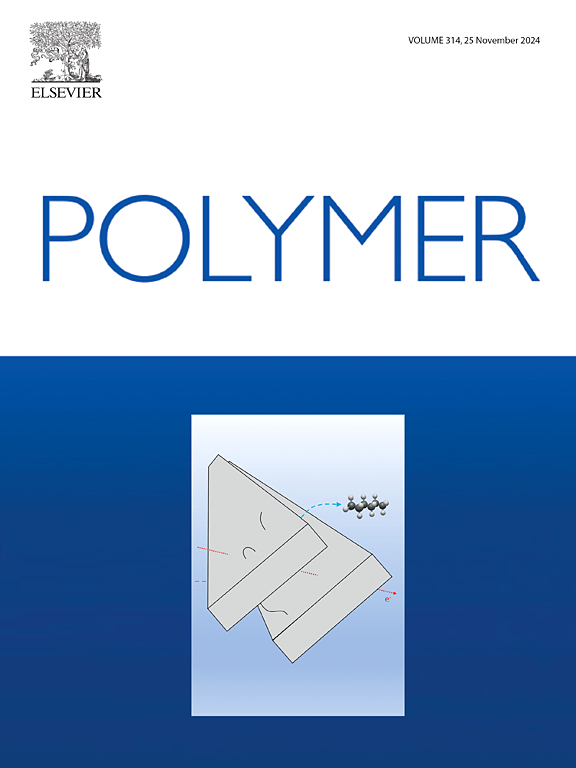Self-nucleation effect in crystallization of Poly(propylene-co-ethylene-co-1-butene) terpolymers
IF 4.1
2区 化学
Q2 POLYMER SCIENCE
引用次数: 0
Abstract
The self-nucleation effect on crystallization kinetics and polymorphism in poly(propylene-co-ethylene-co-1-butene) terpolymer was investigated using differential scanning calorimetry and wide-angle X-ray diffraction. The incorporation of ethylene and 1-butene comonomers induces the occurrence of self-nucleation, which hardly appears in customary isotactic polypropylene homopolymer. Within the incorporation range of 5.5–12.7 mol%, self-nucleation effect could increase the crystallization peak temperature by around 17 °C with respect to the relaxed melt. However, the temperature window of self-nucleation Domain II decreased with increasing comonomer content, where Domain IIa was absent at 12.7 mol%. The successive self-nucleation and annealing (SSA) analysis revealed that the three terpolymers studied exhibited similar regular sequence lengths but various distributions, where the diminishing of the self-nucleation effect was correlated to the reduction in long regular sequences. Additionally, the incorporation of ethylene and 1-butene comonomers facilitated formation of the triclinic γ form, which could be tuned by self-nucleation temperature Ts. In Domain I, the amount of γ form with respect to α form was kept constant. Interestingly, enhancing self-nucleation by lowering Ts significantly increased the content of γ form, as self-nucleation accelerated crystallization kinetics and increased the cooling crystallization temperature. However, the further reduction of Ts within Domain III favored the formation of α form by preserving crystallites from partial melting and reducing regular sequences for the subsequent crystallization.


聚(丙烯-共乙烯-co-1-丁烯)三元共聚物结晶中的自成核效应
采用差示扫描量热法和广角 X 射线衍射法研究了自成核对聚(丙烯-共-乙烯-共-1-丁烯)三元共聚物的结晶动力学和多态性的影响。乙烯和 1-丁烯共聚单体的加入导致了自成核现象的出现,而这种现象在普通的同方向聚丙烯均聚物中几乎不会出现。在 5.5-12.7 摩尔%的掺入量范围内,自核效应可使结晶峰值温度比松弛熔体提高约 17 °C。然而,随着共聚单体含量的增加,自成核域 II 的温度窗口减小,当共聚单体含量为 12.7 摩尔%时,域 IIa 不存在。连续自成核和退火(SSA)分析表明,所研究的三种三元共聚物表现出相似的规则序列长度,但分布各不相同,其中自成核效应的减弱与长规则序列的减少有关。此外,乙烯和 1-丁烯共聚单体的加入促进了三菱γ形的形成,这可以通过自成核温度 Ts 来调节。在域 I 中,γ 形相对于 α 形的数量保持不变。有趣的是,通过降低 Ts 来增强自成核显著增加了 γ 形式的含量,因为自成核加速了结晶动力学并提高了冷却结晶温度。然而,在域 III 内进一步降低 Ts 值有利于形成 α 形,因为这样可以保留结晶颗粒,避免部分熔化,并减少随后结晶的规则序列。
本文章由计算机程序翻译,如有差异,请以英文原文为准。
求助全文
约1分钟内获得全文
求助全文
来源期刊

Polymer
化学-高分子科学
CiteScore
7.90
自引率
8.70%
发文量
959
审稿时长
32 days
期刊介绍:
Polymer is an interdisciplinary journal dedicated to publishing innovative and significant advances in Polymer Physics, Chemistry and Technology. We welcome submissions on polymer hybrids, nanocomposites, characterisation and self-assembly. Polymer also publishes work on the technological application of polymers in energy and optoelectronics.
The main scope is covered but not limited to the following core areas:
Polymer Materials
Nanocomposites and hybrid nanomaterials
Polymer blends, films, fibres, networks and porous materials
Physical Characterization
Characterisation, modelling and simulation* of molecular and materials properties in bulk, solution, and thin films
Polymer Engineering
Advanced multiscale processing methods
Polymer Synthesis, Modification and Self-assembly
Including designer polymer architectures, mechanisms and kinetics, and supramolecular polymerization
Technological Applications
Polymers for energy generation and storage
Polymer membranes for separation technology
Polymers for opto- and microelectronics.
 求助内容:
求助内容: 应助结果提醒方式:
应助结果提醒方式:


